| EMUD Tweeter Repair, part 2 |
I squeezed the rivet tighter hoping to re-secure the connection, without luck. I heated the contact with my soldering pencil and shifted it slightly, thinking there might be some oxidation I could break loose to make a fresh contact. With utter confidence I can say now, do not ever do that! The iron's heat made the situation worse because not only did plastic around the rivet melt, I soon discovered the Mylar strip had melted also! Now I’d have to drill out the rivet and repair the contact area.
|
 |
| Heat damaged a Mylar strip |
|
|
At this point most people would reach for a Dremel high speed tool and “go Rambo” but I feared friction would melt the plastic yet again. I used a very low drill speed, something like 100rpm, with increasing bit sizes until the rivet was cleared away. When the contact was finally lifted clear, that fragile Mylar strip came up with it.
The photo shows where a Mylar strip that was tucked underneath the solder contact had been damaged, melted by me no doubt. It bothered me that the strip could be pulled out of the tweeter with no resistance. Whatever it was supposed to connect to inside, it obviously wasn’t doing a good job of it. The tweeter would have to be opened, which meant breaking off those 6 melted pins that held the grill.
|
 |
| Conductive Mylar strip is too easily removed |
|
|
The little plastic blobs were carefully broken away and the metal grill pulled off. A Mylar disc, made of the same material as that strip, gently stuck to the inside of the grill. The disc side away from the grill is the conductive side. I probably could have pulled the disc away easily but there was no reason to do that. The disc and grill appeared clean and, rather than risk damaging that very thin disc, I left it undisturbed.
|
 |
| Simple design uses only six parts |
|
|
How does the tweeter work? A capacitor sandwich is formed by placing a Mylar disc with conductive coating on one side against a metal grill. The Mylar is a dielectric insulator between two coductive surfaces. When a reasonably high voltage (+200v) is applied across it, electron attraction pulls the disc tightly against the grill and puts tension along the Mylar surface. Audio signals added to the high voltage varies the resulting attraction. The Mylar “vibrates”, ever so slightly, which causes sound to be emitted through small holes in the grill. In fact, it is much like a condenser microphone working in reverse. The Mylar strip that I pulled out is simply a jumper from the riveted solder contact to the conductive side of the disc. It needed to be held against the disc to maintain an electrical connection. A round piece of plastic foam (that round object with a dozen holes in it) originally put pressure on the strip against the disc, but age had very badly degraded it. The foam now crumbled with the slightest touch. I think the foam also serves to hold the mylar disc in place when there is no electric charge (while the radio is off).
|
|
|
The Mylar's conductive coating is thin enough to let light pass yet I measured reasonably low resistance across it, on the order of 20 ohms per centimeter.Gold and nickle vapor coatings are used in many condenser microphones.
Fingerprints? They are factory original!
|
|
|
|
|